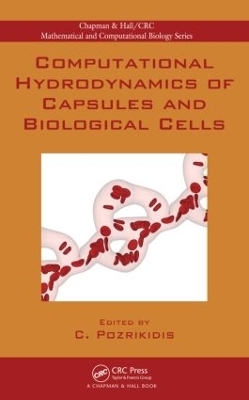
Computational Hydrodynamics of Capsules and Biological Cells
Seiten
2010
Crc Press Inc (Verlag)
978-1-4398-2005-6 (ISBN)
Crc Press Inc (Verlag)
978-1-4398-2005-6 (ISBN)
- Titel z.Zt. nicht lieferbar
- Versandkostenfrei innerhalb Deutschlands
- Auch auf Rechnung
- Verfügbarkeit in der Filiale vor Ort prüfen
- Artikel merken
Spanning biological, mathematical, computational, and engineering sciences, Computational Biofluiddynamics addresses a diverse family of problems involving fluid flow inside and around living organisms, organs, tissue, biological cells, and other biological materials. This book provides a comprehensive introduction to this field.
Spanning biological, mathematical, computational, and engineering sciences, computational biofluiddynamics addresses a diverse family of problems involving fluid flow inside and around living organisms, organs, tissue, biological cells, and other biological materials. Computational Hydrodynamics of Capsules and Biological Cells provides a comprehensive, rigorous, and current introduction to the fundamental concepts, mathematical formulation, alternative approaches, and predictions of this evolving field.
In the first several chapters on boundary-element, boundary-integral, and immersed-boundary methods, the book covers the flow-induced deformation of idealized two-dimensional red blood cells in Stokes flow, capsules with spherical unstressed shapes based on direct and variational formulations, and cellular flow in domains with complex geometry. It also presents simulations of microscopic hemodynamics and hemorheology as well as results on the deformation of capsules and cells in dilute and dense suspensions. The book then describes a discrete membrane model where a surface network of viscoelastic links emulates the spectrin network of the cytoskeleton, before presenting a novel two-dimensional model of red and white blood cell motion. The final chapter discusses the numerical simulation of platelet motion near a wall representing injured tissue.
This volume provides a roadmap to the current state of the art in computational cellular mechanics and biofluiddynamics. It also indicates areas for further work on mathematical formulation and numerical implementation and identifies physiological problems that need to be addressed in future research. MATLAB® code and other data are available at http://dehesa.freeshell.org/CC2
Spanning biological, mathematical, computational, and engineering sciences, computational biofluiddynamics addresses a diverse family of problems involving fluid flow inside and around living organisms, organs, tissue, biological cells, and other biological materials. Computational Hydrodynamics of Capsules and Biological Cells provides a comprehensive, rigorous, and current introduction to the fundamental concepts, mathematical formulation, alternative approaches, and predictions of this evolving field.
In the first several chapters on boundary-element, boundary-integral, and immersed-boundary methods, the book covers the flow-induced deformation of idealized two-dimensional red blood cells in Stokes flow, capsules with spherical unstressed shapes based on direct and variational formulations, and cellular flow in domains with complex geometry. It also presents simulations of microscopic hemodynamics and hemorheology as well as results on the deformation of capsules and cells in dilute and dense suspensions. The book then describes a discrete membrane model where a surface network of viscoelastic links emulates the spectrin network of the cytoskeleton, before presenting a novel two-dimensional model of red and white blood cell motion. The final chapter discusses the numerical simulation of platelet motion near a wall representing injured tissue.
This volume provides a roadmap to the current state of the art in computational cellular mechanics and biofluiddynamics. It also indicates areas for further work on mathematical formulation and numerical implementation and identifies physiological problems that need to be addressed in future research. MATLAB® code and other data are available at http://dehesa.freeshell.org/CC2
C. Pozrikidis is a professor in the Department of Chemical Engineering at the University of Massachusetts, Amherst.
Flow-Induced Deformation of Two-Dimensional Biconcave Capsules. Flow-Induced Deformation of Artificial Capsules. A High-Resolution Fast Boundary-Integral Method for Multiple Interacting Blood Cells. Simulating Microscopic Hemodynamics and Hemorheology with the Immersed-Boundary Lattice-Boltzmann Method. Front-Tracking Methods for Capsules, Vesicles, and Blood Cells. Dissipative Particle Dynamics Modeling of Red Blood Cells. Simulation of Red Blood Cell Motion in Microvessels and Bifurcations. Multiscale Modeling of Transport and Receptor-Mediated Adhesion of Platelets in the Bloodstream. Index.
| Reihe/Serie | Chapman & Hall/CRC Computational Biology Series |
|---|---|
| Zusatzinfo | 2 Tables, black and white; 114 Illustrations, black and white |
| Verlagsort | Bosa Roca |
| Sprache | englisch |
| Maße | 156 x 234 mm |
| Gewicht | 612 g |
| Themenwelt | Mathematik / Informatik ► Mathematik ► Algebra |
| Mathematik / Informatik ► Mathematik ► Angewandte Mathematik | |
| Medizin / Pharmazie ► Physiotherapie / Ergotherapie ► Orthopädie | |
| Naturwissenschaften ► Biologie ► Zellbiologie | |
| Naturwissenschaften ► Physik / Astronomie | |
| Technik ► Medizintechnik | |
| Technik ► Umwelttechnik / Biotechnologie | |
| ISBN-10 | 1-4398-2005-8 / 1439820058 |
| ISBN-13 | 978-1-4398-2005-6 / 9781439820056 |
| Zustand | Neuware |
| Informationen gemäß Produktsicherheitsverordnung (GPSR) | |
| Haben Sie eine Frage zum Produkt? |
Mehr entdecken
aus dem Bereich
aus dem Bereich
Mathematik von Studierenden für Studierende erklärt und kommentiert
Buch (2024)
Springer Spektrum (Verlag)
34,99 €
Sieben ausgewählte Themenstellungen
Buch | Softcover (2024)
De Gruyter Oldenbourg (Verlag)
64,95 €


